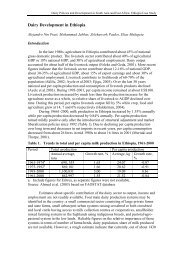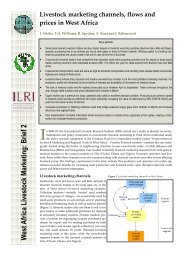Designing ecological and biodiversity sampling strategies
Designing ecological and biodiversity sampling strategies
Designing ecological and biodiversity sampling strategies
Create successful ePaper yourself
Turn your PDF publications into a flip-book with our unique Google optimized e-Paper software.
hierarchy. While sometimes necessary, this approach is limited because the‘representivity’ of the sampled area (the extent to which findings can reasonably beassumed to apply to a larger population) depends on the judgement of the designer,not on any inherent property of the design. It is therefore open to dispute when resultsare presented. If a subjective sample of size 1 is taken, this is equivalent to limitingthe study area. For example, if a single ‘window’ is subjectively placed in abenchmark area, then in fact we have reduced the study to that window, <strong>and</strong> any claimto represent the benchmark area depends solely on the expertise of the designer.Systematic <strong>sampling</strong> has found much application in ecology, both with 1-d transects<strong>and</strong> 2-d grids. In the case of transects, samples are selected at points in a fixeddistance apart along a predetermined line. For grid <strong>sampling</strong>, a (usually) rectangulargrid is defined in the area <strong>and</strong> samples taken at each intersection point. The potentialadvantages of these types of systematic <strong>sampling</strong> derive from both theory <strong>and</strong>practice. The practical advantages include:• Ease of locating <strong>sampling</strong> points <strong>and</strong> description of the location <strong>and</strong> means of findingthem in the field. For example, the protocol may be something as simple as, ‘from thestarting point, walk north <strong>and</strong> sample every 50m’.• Ease of planning field work, for example, estimating the time needed to sample a fixednumber of points.The statistical reason for using grid <strong>sampling</strong> is because they can be efficient(Webster <strong>and</strong> Oliver, 1990). Consider a study with the objective of measuring theaverage or total of some quantity (for example total soil carbon in the study area oraverage number of beetles per m 2 ). A grid sample will give a better estimate than asimple r<strong>and</strong>om sample of the same size if the measured quantity varies in a patchyway, which is typical for environmental <strong>and</strong> biological variables. The efficiencycomes from the fact that closely neighbouring points are similar to each other <strong>and</strong> sodo not add much new information. In addition, the grid spreads the sample as evenlyas possible through the study area. For similar reasons, the grid approach can beexpected to be good for compiling the inventory of a study area, except that it maymiss rare niches (see below).There are some negative aspects of grid <strong>sampling</strong>. These include:1. Some points of the grid may be at points which should not be included in the study,such as roads or water bodies. Obviously these must be excluded.15
















